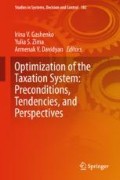Abstract
The chapter dwells on theoretical foundations of the shadow economy, considers the types of existence and growth of the shadow sector, evaluates the scale and role of the shadow economy, and studies pros and cons of existence of the shadow economy, as well as peculiarities of the model rows of measuring the shadow economy, related to tax evasion at the national level. For adapting these methods to the regional level, correspondence of the national methods and indicators in the regional aspect is viewed, and the most adequate indicators are selected, which are presented in the form of the model of well-balanced taxation. Practical implementation of the model will allow regulating the volumes of the shadow economy for making more justified decisions on improvement of the tax policy at various levels of management.
Access this chapter
Tax calculation will be finalised at checkout
Purchases are for personal use only
References
Allingham, M., & Sandmo, A. (1972). Income tax evasion: A theoretical analysis. Journal of Public Economics, 1, 323–338.
Buehn, A., Karamann, A., & Schneider, F. (2009). Shadow economy and do it yourself activities: The German case. Journal of Institutional and Theoretical Economics JITE, 165(4), 701–722.
Dell’Anno, R. (2007). The shadow economy in Portugal: An analysis with the MIMIC approach. Journal of Applied Economics, X(2), 253–277.
Giles, D., & Tedds, L. (2002). Taxes and the Canadian Underground Economy. In Canadian tax paper (Vol. 106, 270 p.).
Johnson, S., Kaufmann, D., & Zoido-Lobaton, P. (1998). Regulatory discretion and the unofficial economy. American Economic Review, 88(2), 387–392.
Tanzi, V. (1999). Uses and abuses of estimates of the underground economy. The Economic Journal, 109, 338–347.
Author information
Authors and Affiliations
Corresponding author
Editor information
Editors and Affiliations
Rights and permissions
Copyright information
© 2019 Springer Nature Switzerland AG
About this chapter
Cite this chapter
Pozdnyakova, U.A., Bogoviz, A.V., Lobova, S.V., Ragulina, J.V., Popova, E.V. (2019). The Model of Well-Balanced Taxation for Overcoming the Shadow Economy in Modern Russia. In: Gashenko, I., Zima, Y., Davidyan, A. (eds) Optimization of the Taxation System: Preconditions, Tendencies and Perspectives. Studies in Systems, Decision and Control, vol 182. Springer, Cham. https://doi.org/10.1007/978-3-030-01514-5_24
Download citation
DOI: https://doi.org/10.1007/978-3-030-01514-5_24
Published:
Publisher Name: Springer, Cham
Print ISBN: 978-3-030-01513-8
Online ISBN: 978-3-030-01514-5
eBook Packages: Intelligent Technologies and RoboticsIntelligent Technologies and Robotics (R0)

